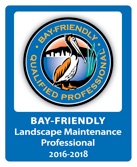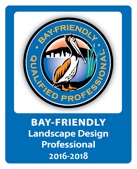Bay-Friendly Landscaping



The Bay-Friendly landscape professional can create and maintain healthy, beautiful and vibrant landscapes by:
✔Landscaping in harmony with the natural conditions of the San Francisco Bay watershed
✔Reducing waste and recycling materials
✔Nurturing healthy soils while reducing fertilizer use
✔Conserving water, energy and topsoil
✔Using integrated pest management to minimize chemical use
✔Reducing storm water runoff and air pollution
✔Protecting and enhancing wildlife habitat and diversity
Why is Bay-Friendly Landscaping Important?
Over the last two decades, there has been a significant reduction in plant debris landfilled in the San Francisco Bay Area, due in large part to residential recycling programs and because tens of thousands of households practice backyard composting. This positive trend reflects the interest of residents in recycling plant debris and reducing waste. But more needs to be done, as tons of plant debris are still thrown away each year. Twenty-three states have banned or limited the disposal of plant debris in their landfills; however, California has not and statewide, 2.7 million tons of plant debris are landfilled each year. Leaves and clippings alone are sixth out of the ten most prevalent material types in California’s overall disposal waste system. In Alameda County alone 110,000 tons of plant debris are still landfilled each year, much of which passes through the hands of a professional landscaper.
Other types of waste, including plastics and hazardous wastes, are also generated by conventional landscaping practices. The horticultural industry in the US throws away almost a half- billion pounds of greenhouse film, plastic pots and plastic ground cover each year. Annual disposal of leftover pesticides used by residents costs tens of thousands of dollars for each Bay Area County — and only a fraction of the pesticides are disposed of properly.
Bay-Friendly landscaping minimizes the use of plastics and pesticides, and diverts plant debris from the landfill by preventing waste in the first place through careful plant selection, watering and fertilizing or reusing plant material through grasscycling, mulch and compost. Because generating plant debris is linked to a wide range of landscaping practices — such as watering and fertilizing — this integrated solution is essential.
( from the Bay-friendly landscape guidelines book. Download the PDF here )
To Find out more about Bay-friendly Landscaping, the courses they offer for both professional and homeowners, and the garden tours they organize every spring, visit: http://www.rescapeca.org
Bay-Friendly Landscaping is. . .
A whole systems approach to the design, construction and maintenance of the landscape in order to support the integrity of one of California’s most magnificent ecosystems, the San Francisco Bay watershed.
Cheryl Hawkins is a Bay-Friendly Qualified Professional, since 2011. We support the use of Bay-Friendly practices, and implement them whenever possible. Here is more information on what Bay-Friendly Landscaping is and how it is applied:







